|
La Roche en Ardenne
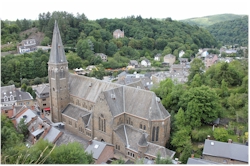 General.
When you arrive in the small town you will immediately see where
it got its name "La Roche" (or "the Rock") from.
This settlement is located in a bend of the Ourthe river with
the ruins of a mighty feudal stronghold at the top of a natural
rock. This castle is the big eye-catcher and the symbol of
La Roche. With the Ourthe river meandering at its feet and
the woods of the Ardennes in the surrounding hils, it should be
no surprise that this region is very much loved with visitors
who like active excursions. There are plenty of
possibilities for kayaking, hiking or cycling in the immediate
area. The center of the town itself is partially car-free
and there are numerous shops with authentic products of the
region, restaurants and terraces. La Roche also has other
trump cards next to nature: the castle, pottery and not to
forget: the heritage of the Battle of the Bulge (Second World
War). General.
When you arrive in the small town you will immediately see where
it got its name "La Roche" (or "the Rock") from.
This settlement is located in a bend of the Ourthe river with
the ruins of a mighty feudal stronghold at the top of a natural
rock. This castle is the big eye-catcher and the symbol of
La Roche. With the Ourthe river meandering at its feet and
the woods of the Ardennes in the surrounding hils, it should be
no surprise that this region is very much loved with visitors
who like active excursions. There are plenty of
possibilities for kayaking, hiking or cycling in the immediate
area. The center of the town itself is partially car-free
and there are numerous shops with authentic products of the
region, restaurants and terraces. La Roche also has other
trump cards next to nature: the castle, pottery and not to
forget: the heritage of the Battle of the Bulge (Second World
War).
There are quite a bit of visitors
during the holiday periods; the many campings and other lodging
accommodation bear evidence of that. The area is very
popular with visitors from Flanders and the Netherlands.
English speaking visitors should not despair because all
information signs are also in English and you will be helped in
your language with a smile.
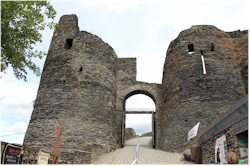 The
feudal castle.
This region has been
inhabited since long time and that is no coincidence. The
presence of the Ourthe river ensured a link making it possible
for people to move fairly easily and to trade with eachother.
It's by consequence no coincidence that a stronghold was built
here on this rock next to a bend in the river.
Archeological finds prove that people were already living here
in prehistoric times. Lateron, Romans built a small
fortress on the spot where there alledgedly used to be a Celtic
settlement. After the Romans were driven out, the rock
remained a fortified place which was transformed into a mighty
castle over the centuries. This castle was at the peak of
its might between the 12th and the 17th century. In 1681,
La Roche was occupied by the French (Louis XIV). The
adapted the castle to the needs of modern artillery and
constructed amongst other things a covered reservoir to provide
the soldiers with fresh drinking water. Thing to a turn
for the worse when Joseph II gave up the place as a military
stronghold. From that moment on, the castle fell prey to
natural decay and plunderers who used it as a quarry for the
recuperation of construction materials. The
feudal castle.
This region has been
inhabited since long time and that is no coincidence. The
presence of the Ourthe river ensured a link making it possible
for people to move fairly easily and to trade with eachother.
It's by consequence no coincidence that a stronghold was built
here on this rock next to a bend in the river.
Archeological finds prove that people were already living here
in prehistoric times. Lateron, Romans built a small
fortress on the spot where there alledgedly used to be a Celtic
settlement. After the Romans were driven out, the rock
remained a fortified place which was transformed into a mighty
castle over the centuries. This castle was at the peak of
its might between the 12th and the 17th century. In 1681,
La Roche was occupied by the French (Louis XIV). The
adapted the castle to the needs of modern artillery and
constructed amongst other things a covered reservoir to provide
the soldiers with fresh drinking water. Thing to a turn
for the worse when Joseph II gave up the place as a military
stronghold. From that moment on, the castle fell prey to
natural decay and plunderers who used it as a quarry for the
recuperation of construction materials.
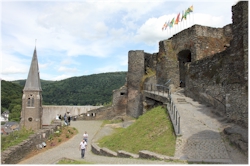 Nowadays,
the castle is the main attraction for the visitors of the town.
Parts have in the meantime been restored and there are plans to
repair more of it. A majestic ruins as this one appeal to
one's imagination so it's no surprise that this castle has its
own ghost: Berthe. Berthe was the daughter of the lord of
La Roche. He organized a tournament to marry his daughter
to the winner. One of the contestants however was already
engaged to another woman. The latter found out that her
husband-to-be was going to compete and out of jealousy she sold
her soul to the devil. In return she received the power to
beat her future husband. Disguised as a mysterious knight,
she entered the tournament and succeeded to win it. The
next day both the mysterious knight and Berthe were found dead
at the foot of the castle. Ever since that day, the spirit
of Berthe has been wandering around the ruins of the castle.
During the months of July and August there is a light game is
projected on the castle in honour of Berthe. The castle is
also the scene of a medieval weekend and regularly there are
demonstrations in falconry and archery. More info:
www.chateaudelaroche.be . Nowadays,
the castle is the main attraction for the visitors of the town.
Parts have in the meantime been restored and there are plans to
repair more of it. A majestic ruins as this one appeal to
one's imagination so it's no surprise that this castle has its
own ghost: Berthe. Berthe was the daughter of the lord of
La Roche. He organized a tournament to marry his daughter
to the winner. One of the contestants however was already
engaged to another woman. The latter found out that her
husband-to-be was going to compete and out of jealousy she sold
her soul to the devil. In return she received the power to
beat her future husband. Disguised as a mysterious knight,
she entered the tournament and succeeded to win it. The
next day both the mysterious knight and Berthe were found dead
at the foot of the castle. Ever since that day, the spirit
of Berthe has been wandering around the ruins of the castle.
During the months of July and August there is a light game is
projected on the castle in honour of Berthe. The castle is
also the scene of a medieval weekend and regularly there are
demonstrations in falconry and archery. More info:
www.chateaudelaroche.be .
 The
Battle of the Bulge.
La Roche was initially liberated on 10 September 1944.
However, on the 16th of December 1944 the offensive of the
Ardennes (later on called the Battle of the Bulge) started.
It was an attempt of the German army to recapture the city of
Antwerp. The attack came as a complete surprise for the
American troops that were stationed in the Ardennes. On 21
December, the town of La Roche was hastily evacuated by the
Americans after which it was taken back by the Germans. As
from 22 December, the town was a target for the American
artillery and this up till 12 January 1945, the day that the
town was liberated again by allied troops. The town was
not only shelled by the artillery but it was also bombarded from
the air. Several air raids were executed during those few
weeks of occupation. The result was desastrous with lots
of civilian casualties and the historic town center virtually
reduced to rubble. The museum on the Battle of the Bulge
sheds some light on these dark pages from the town's history and
boasts a very extended collection of material from that period.
You can find it in the center near the church. It has
three floors with vehicles, weapons, clothes and other material
from the American, English and German army. One of the
highlights is undoubtely an enigma decoding machine that was
used by the Germans. A recommendation for everyone who is
interested in the Second World War. More info:
www.batarden.be . The
Battle of the Bulge.
La Roche was initially liberated on 10 September 1944.
However, on the 16th of December 1944 the offensive of the
Ardennes (later on called the Battle of the Bulge) started.
It was an attempt of the German army to recapture the city of
Antwerp. The attack came as a complete surprise for the
American troops that were stationed in the Ardennes. On 21
December, the town of La Roche was hastily evacuated by the
Americans after which it was taken back by the Germans. As
from 22 December, the town was a target for the American
artillery and this up till 12 January 1945, the day that the
town was liberated again by allied troops. The town was
not only shelled by the artillery but it was also bombarded from
the air. Several air raids were executed during those few
weeks of occupation. The result was desastrous with lots
of civilian casualties and the historic town center virtually
reduced to rubble. The museum on the Battle of the Bulge
sheds some light on these dark pages from the town's history and
boasts a very extended collection of material from that period.
You can find it in the center near the church. It has
three floors with vehicles, weapons, clothes and other material
from the American, English and German army. One of the
highlights is undoubtely an enigma decoding machine that was
used by the Germans. A recommendation for everyone who is
interested in the Second World War. More info:
www.batarden.be .
Nature.
In La Roche you have the Ourthe river and the surrounding
woodlands but just outside the town there is also a wildlife
parc: "Le Parc à
Gibier". You will not only encounter different
species of dear and cattle but also owls, foxes, raccoons and
even wolves. Ideal for an excursion with the family.
More info:
www.parc-gibier-laroche.be.
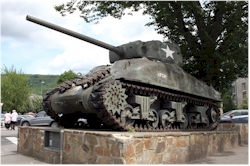 Other
sights.
The military past takes up a very important place in the town.
Besides the castle and the museum on the Battle of the Bulge,
you can also find a monument for the victims of the war and two
restored tanks. In the center you can see an American
M4A1 Sherman tank and an English Destroyer M10 on the opposite
side of the river outside the town center. If you desire
more peaceful things to see, you might find something to your
liking in the museum "Grès de La Roche", that focusses on the
famous regional pottery. More info:
www.gresdelaroche.be. Other
sights.
The military past takes up a very important place in the town.
Besides the castle and the museum on the Battle of the Bulge,
you can also find a monument for the victims of the war and two
restored tanks. In the center you can see an American
M4A1 Sherman tank and an English Destroyer M10 on the opposite
side of the river outside the town center. If you desire
more peaceful things to see, you might find something to your
liking in the museum "Grès de La Roche", that focusses on the
famous regional pottery. More info:
www.gresdelaroche.be.
How to get
to
La Roche en Ardenne? Own transportation is the
easiest way to get to the town. Parking in the center is
paying; outside it is free. Alternatively you can come by
train through a neighbouring station (Melreux or Marloie) and
take a bus from there.
Tours &
info. You can find information on the town and the
sights in and around it at the tourist office that is situated
in the center
(Place du Marché 15). No issues if you don't speak French;
you will be helped in English without issues.
Links.
- Tourist Office La Roche:
www.la-roche-tourisme.com
- Website museum Battle of the Bulge:
www.batarden.be
- Website La Roche castle:
www.chateaudelaroche.be
- Wildlife parc Parc à Gibier:
www.parc-gibier-laroche.be
- Museum La Roche pottery:
www.gresdelaroche.be.
Picture 1: La Roche church seen from
the castle
Picture 2: access gate to the castle
Picture 3: the castle
Picture 4: display from the museum on the Battle of the Bulge
Picture 5: Sherman M4A1 tank
|

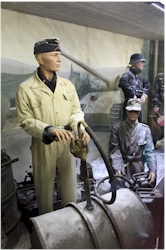
 General.
When you arrive in the small town you will immediately see where
it got its name "La Roche" (or "the Rock") from.
This settlement is located in a bend of the Ourthe river with
the ruins of a mighty feudal stronghold at the top of a natural
rock. This castle is the big eye-catcher and the symbol of
La Roche. With the Ourthe river meandering at its feet and
the woods of the Ardennes in the surrounding hils, it should be
no surprise that this region is very much loved with visitors
who like active excursions. There are plenty of
possibilities for kayaking, hiking or cycling in the immediate
area. The center of the town itself is partially car-free
and there are numerous shops with authentic products of the
region, restaurants and terraces. La Roche also has other
trump cards next to nature: the castle, pottery and not to
forget: the heritage of the Battle of the Bulge (Second World
War).
General.
When you arrive in the small town you will immediately see where
it got its name "La Roche" (or "the Rock") from.
This settlement is located in a bend of the Ourthe river with
the ruins of a mighty feudal stronghold at the top of a natural
rock. This castle is the big eye-catcher and the symbol of
La Roche. With the Ourthe river meandering at its feet and
the woods of the Ardennes in the surrounding hils, it should be
no surprise that this region is very much loved with visitors
who like active excursions. There are plenty of
possibilities for kayaking, hiking or cycling in the immediate
area. The center of the town itself is partially car-free
and there are numerous shops with authentic products of the
region, restaurants and terraces. La Roche also has other
trump cards next to nature: the castle, pottery and not to
forget: the heritage of the Battle of the Bulge (Second World
War). 
 Nowadays,
the castle is the main attraction for the visitors of the town.
Parts have in the meantime been restored and there are plans to
repair more of it. A majestic ruins as this one appeal to
one's imagination so it's no surprise that this castle has its
own ghost: Berthe. Berthe was the daughter of the lord of
La Roche. He organized a tournament to marry his daughter
to the winner. One of the contestants however was already
engaged to another woman. The latter found out that her
husband-to-be was going to compete and out of jealousy she sold
her soul to the devil. In return she received the power to
beat her future husband. Disguised as a mysterious knight,
she entered the tournament and succeeded to win it. The
next day both the mysterious knight and Berthe were found dead
at the foot of the castle. Ever since that day, the spirit
of Berthe has been wandering around the ruins of the castle.
During the months of July and August there is a light game is
projected on the castle in honour of Berthe. The castle is
also the scene of a medieval weekend and regularly there are
demonstrations in falconry and archery. More info:
Nowadays,
the castle is the main attraction for the visitors of the town.
Parts have in the meantime been restored and there are plans to
repair more of it. A majestic ruins as this one appeal to
one's imagination so it's no surprise that this castle has its
own ghost: Berthe. Berthe was the daughter of the lord of
La Roche. He organized a tournament to marry his daughter
to the winner. One of the contestants however was already
engaged to another woman. The latter found out that her
husband-to-be was going to compete and out of jealousy she sold
her soul to the devil. In return she received the power to
beat her future husband. Disguised as a mysterious knight,
she entered the tournament and succeeded to win it. The
next day both the mysterious knight and Berthe were found dead
at the foot of the castle. Ever since that day, the spirit
of Berthe has been wandering around the ruins of the castle.
During the months of July and August there is a light game is
projected on the castle in honour of Berthe. The castle is
also the scene of a medieval weekend and regularly there are
demonstrations in falconry and archery. More info:

